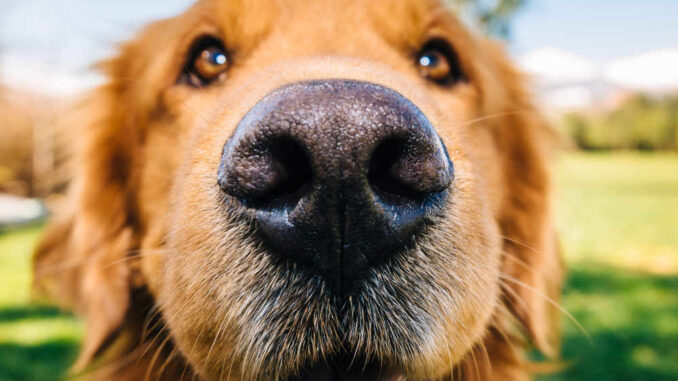
This article was updated on January 12th, 2024

Dogs use their nose and sense of smell to explore the world around them. As most owners know, dogs will sniff just about anything! As a veterinarian, I have seen many nose issues, ranging from scabs and infections to warts and nasal tumors. While some of these issues are harmless, others can be more serious and even life-threatening.
In this article, I will present 11 common nose issues in dogs, along with pictures, to help you understand what might be going on with your dog.
“It’s important to realize that in addition to a change in the appearance of your dog’s nose, your dog may also display other symptoms such as nasal discharge, nose bleeds, sneezing, or excessive itching. Pay careful attention to these as they may help determine the underlying cause of your dog’s symptoms.”
11 common dog nose issues in dogs [with pictures]
In the sections below, we will review common causes of nose scabs, bumps and spots, starting with scabs:
1. Nose scabs (caused by infections, parasites or allergies)
Scabbing can take on many different appearances, from white crust on a dog’s nose, a sore or dry nose or even pink spots on a dog’s nose. Scabs can be the result of an injury but also often indicate that there is an underlying medical issue causing these scabs. The most common offenders include:
Bacterial infections
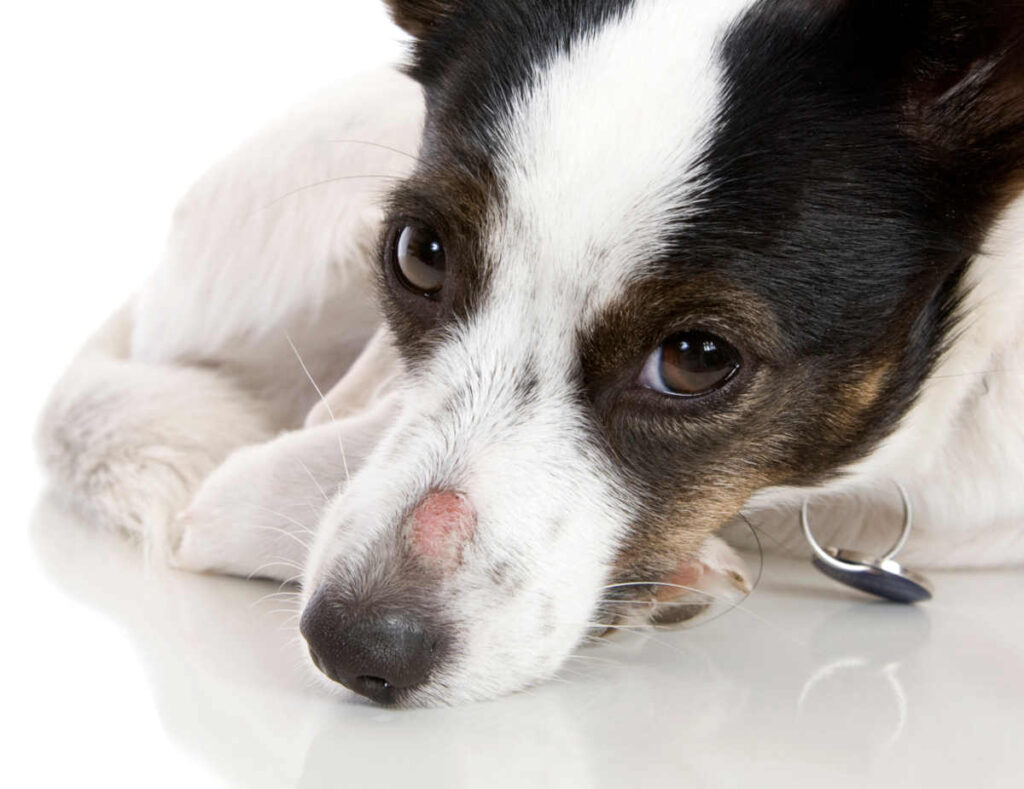
Any small wounds or abrasions will provide an opportunity for bacteria to invade the skin of your dog’s nose and multiply in number, causing damage and irritation to the surrounding tissue in the process. A red and inflamed nose, especially if there is pus or discharge present, will often be an indication that a skin infection is present. While uncomfortable for your dog, most infections are treatable; mild infections may resolve on their own, whereas more severe ones will likely require antibiotics prescribed by your vet.
Fungal infections
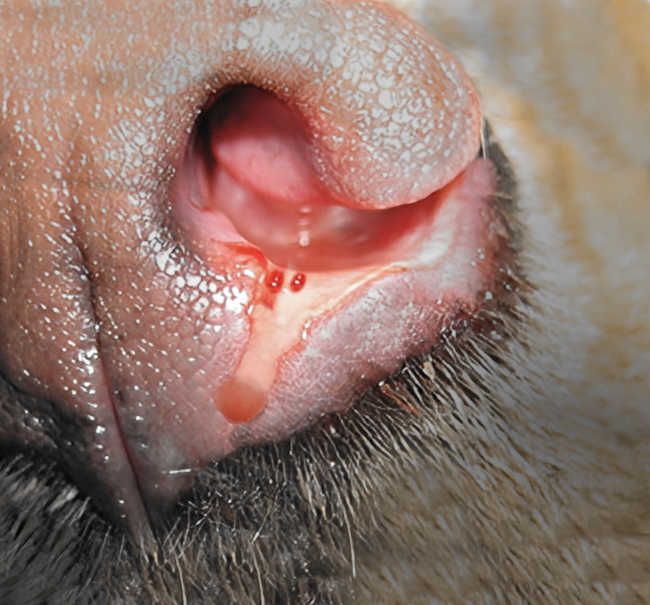
The two most common fungi that can affect the nasal area are ‘ringworm’ and ‘Aspergillus’. Ringworm often presents as circular, hairless lesions, whereas aspergillus often appears as white, ulcerated lesions. Owners will often describe such lesions as a white crust on their dog’s nose.
Aspergillus, in particular, can become quite difficult to treat if left too long, so if you suspect a fungal infection seek veterinary help as soon as possible.
Veterinarian Tip: Fungal infections can be contagious to other pets as well as humans, so keep your dog isolated and wash your hands after petting them until they are no longer contagious.
Mange
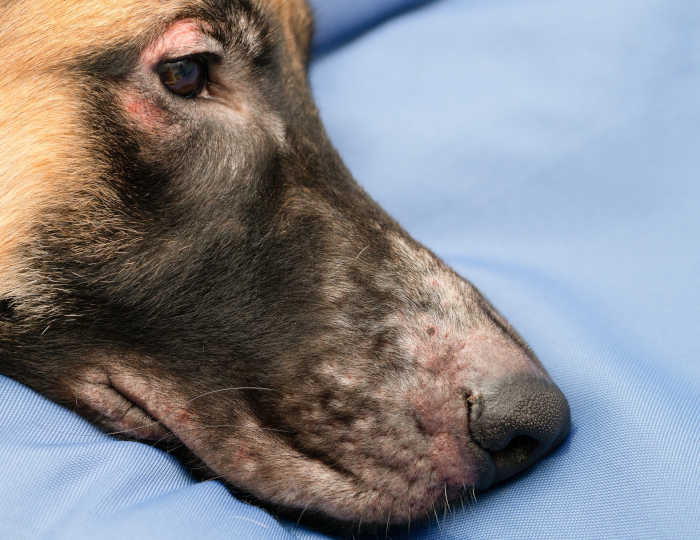
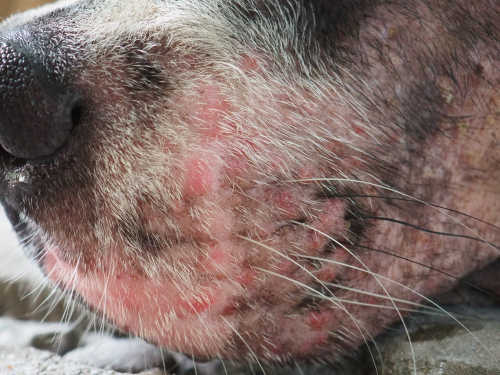
Infestation with mites is known as mange. A specific type of mite called Demodex can affect the skin on the nose; this results in hair loss and scabbing. Dogs affected will often become very itchy as well. Mange can be easily prevented and treated with antiparasitic treatments. Learn more about Mange.
Autoimmune disease
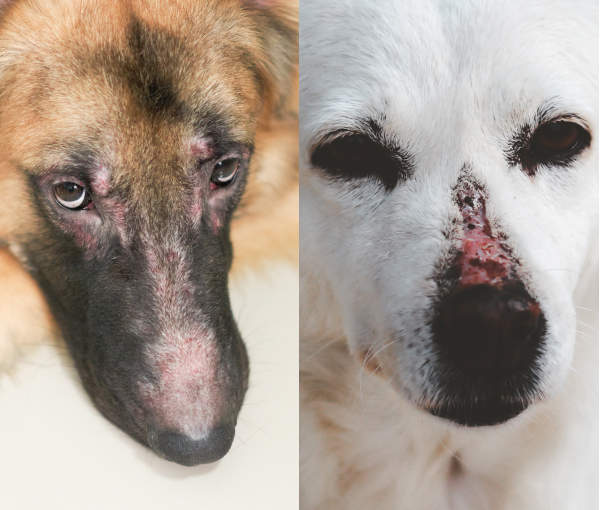
Some autoimmune conditions cause your dog’s own immune system to attack the skin cells on the nose. This results in inflammation, shedding of the skin and makes the area vulnerable to secondary bacterial or fungal infections. Two such autoimmune conditions are cutaneous lupus and pemphigus. These are usually diagnoses of exclusion – other more common conditions are ruled out first; if you suspect your dog might have an autoimmune condition, then consult your veterinarian immediately.
Allergies
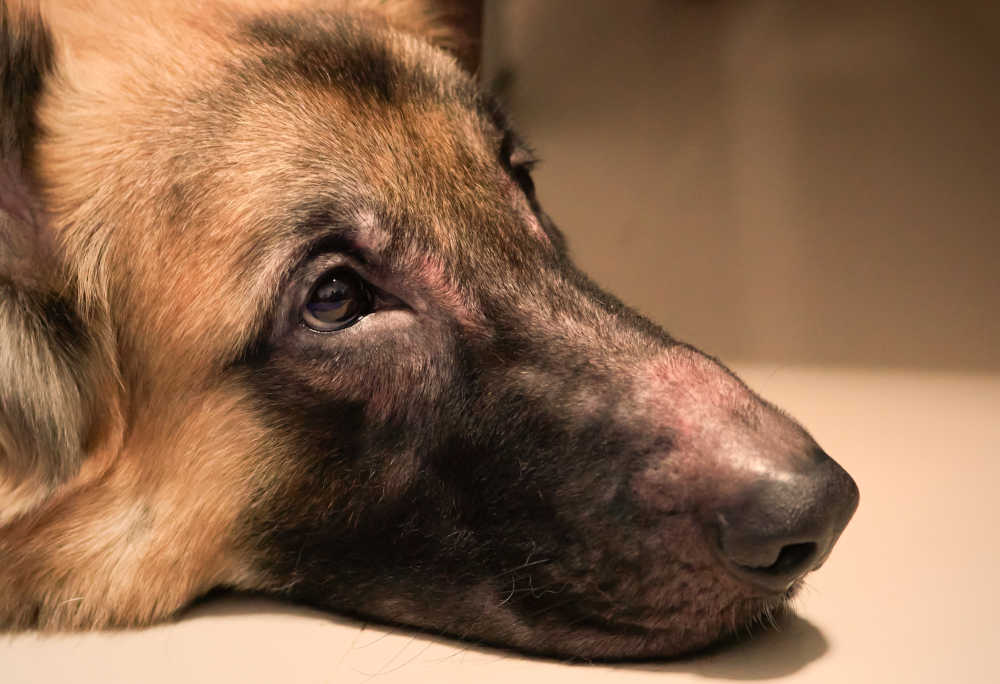
Allergies are very common in dogs: environmental or food allergies can result in your dog developing lesions on their nose or face. I’ve had owners explain that their dog suddenly has a pink or red bump or spot on their nose – this is often a result of an allergic reaction.
A dog suffering from allergies will often exhibit symptoms such as itching, scratching, licking their paws, and sneezing, along with skin issues or gastrointestinal issues.
Allergens cause inflammation in the skin resulting in red, inflamed lesions. Furthermore, this damages the skin’s natural barrier to infection, allowing bacteria to get in and cause further damage.
Learn more about Skin Issues Caused by Allergies.
Dry nose (Hyperkeratosis)
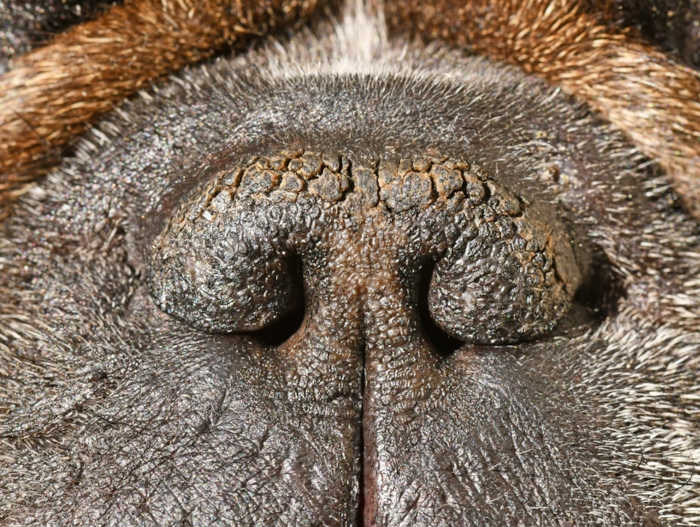
Your dog’s scabby or crusty nose might simply be due to dry skin. Flat-faced breeds such as French Bulldogs and Boxers tend to be more susceptible to this. A simple fix is to apply Vaseline twice daily to help keep the moisture in.
2) Lumps and bumps on a dog’s nose
Benign warts or growths:
Growths, warts, and tumors can appear anywhere on your dog’s body, and the nose is no exception. Owners will explain that there’s a bump or red raised spots on their dog’s nose. The warts on the picture below are pink, furless, and slightly raised, just above the dog’s nose:
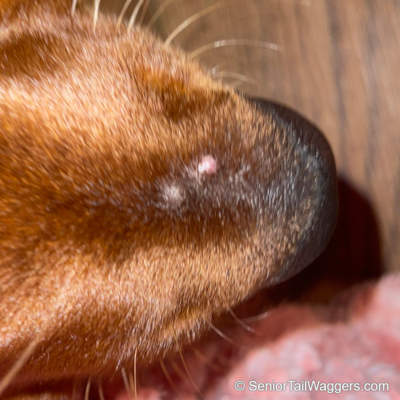
These benign growths can often be left alone if they don’t bother your dog. However, you should still consult with your vet to make sure that a small bump is actually not cancerous: it’s often not possible to diagnose a lump just by looking at it (learn more about the process of diagnosing new lumps).
Tumors
while nasal tumors are not very common, accounting for 1% of tumors in older dogs, it’s still good to be aware of what to look out for and when you should visit the vet. These tumors can be benign or malignant (cancerous) – unfortunately, about 2/3rds of nasal tumors are cancerous.
Malignant nasal tumors can vary in appearance, and the most common types include adenocarcinomas, sarcomas, and squamous cell carcinomas.
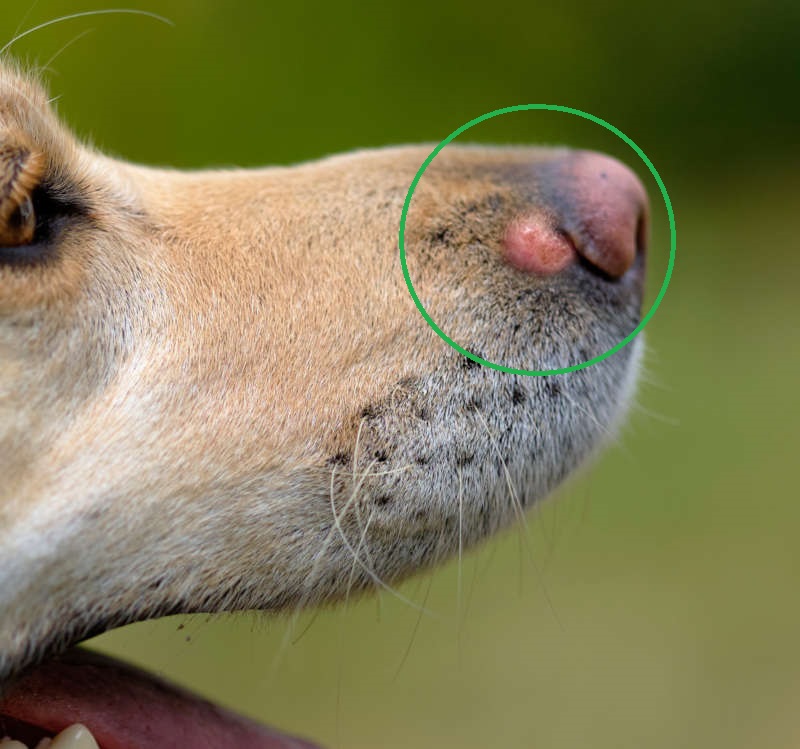
In addition to the appearance of a growth on your dog’s nose, other symptoms to look out for include:
- Nasal discharge
- Nose bleeding
- Asymmetry of the face or deformity
- Twitching of facial muscles/neurological symptoms
- Sneezing
Nasal tumors are diagnosed through CT scans and sampling of the mass to determine if it is malignant or not. Because of the location of these tumors, surgical removal is often very challenging or not possible, and as such malignant nasal tumors carry a guarded prognosis.
While chemotherapy is an option to treat nasal tumors, it generally only has a 30% response rate. Radiotherapy is the treatment of choice which involves irradiating the cancerous cells to prevent further growth. The prognosis will depend on the type of tumor present, how soon treatment is started, and the location on or within the nasal cavity. Most nasal tumors have survival times of about 12 months unless there is an extension of the tumor into the brain which results in a reduced survival time of 4-6 months. Nasal lymphoma, a type of cancer, has a slightly better survival time of 2 years or more.
Related post: red spots on a dog’s nose.
3) Red spots on the nose
Nose pimples or red bumps can be caused by an injury, allergy, infection, or acne.
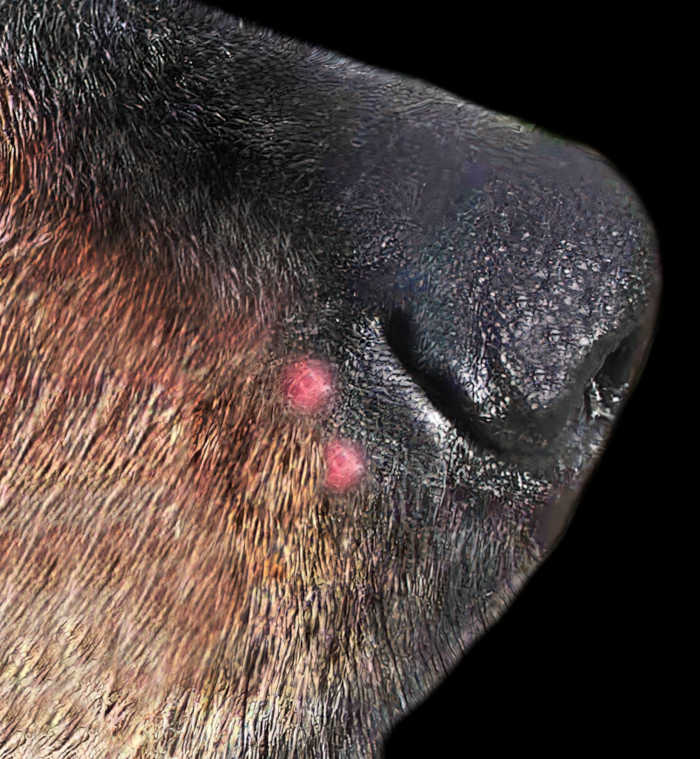
“Most of the time, red bumps or nose pimples are not a major concern. Depending on the cause, these bumps will sometimes clear up on their own; other times, they may require topical or oral medications.”
Here a few common reasons why you may see a red bump on your dog’s nose:
Injury: Dogs explore the world with their noses and this often leads to them poking them in things they shouldn’t. If your dog has got on the wrong side of a thorny bush, a cat, or even the corner of a table, you may see the evidence on their nose. If it’s sore and bothering them, it’s best to get it seen by your vet. However, if it’s only a small red spot or graze, it’s likely to heal by itself.
Allergies, bites, and stings: Dogs’ inclination to explore the world with their nose can also lead to ‘contact allergies’ (for example, an allergy to a specific plant), insect bites, and stings. These can cause a reddened area or spot to appear as well as itching and swelling. Pictured below is a small red bump due to an insect bite:
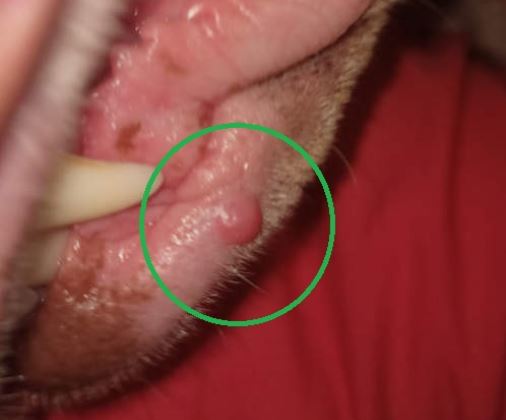
Dog Acne: Dog acne typically manifests as small, red bumps or pustules on a dog’s chin or muzzle, resembling human acne. Learn more about acne with pictures and advice from our veterinarians.

If your dog has small red spots on their nose, read our article about red spots on a dog’s nose.
Can I just monitor my dog and wait?
Not all of the conditions above will require immediate veterinary attention. If the scab or soreness is very mild, then it may be okay to wait and see if the lesion gets worse. Many red spots on your dog’s nose caused by an allergic reaction will resolve themselves as long as the original allergen isn’t still present. Similarly, mild bacterial infections of the skin on your dog’s nose might resolve themselves with time.
However, lesions that aren’t getting better or that are causing a lot of discomfort will likely require veterinary intervention. Delaying veterinary treatment is likely to make things worse for your dog.
Similarly, for the reasons listed above, any lumps or bumps on your dog’s nose should be investigated sooner rather than later because of their tendency to be malignant.
Veterinarian Tip: Cancers left untreated can grow too large to remove completely as well as spread to vital organs, so any new mass on a dog should be evaluated by a veterinarian.
Signs that your dog’s lump or bump needs veterinary attention
While a lump on your dog’s nose may be benign and nothing to worry about, there are some signs that might indicate that the growth is more sinister and should be investigated immediately. If the lump on your dog’s nose displays or results in any of the following, then see your vet as soon as possible:
- Growing rapidly
- Redness or ulceration of the skin over the lump
- Neurological symptoms such as muscle twitching on the face
- Excessive sneezing
- Nasal discharge or nose bleeds
Your vet can help diagnose the issue with tests such as skin scrapes or biopsies
Vets have a multitude of tools at their disposal to help them diagnose what might be causing your dog’s scabs, warts, lumps or bumps,
Skin srapes: Scabbing or flakey skin can be tested by looking under the microscope at a sample of your dog’s skin. Your vet might perform a skin scrape – this involves gently scraping a scalpel blade over the surface of your dog’s skin to remove the top layers of cells; these are then placed on a microscope slide for analysis. malignant.
Hair analysis: Similarly, hair can be plucked from the lesions to be analyzed. This allows your vet to get a glimpse into what type of cells are present and if there are any bacterial or parasitic infections present. These samples can also be cultured in a petri-dish to identify certain types of fungi or bacteria.
Lump biopsies: Lumps and bumps are tested by taking a sample of the growth for analysis under a microscope – this allows identification of the types of cells present and if there are signs of cancer. This sample can be taken in two ways – by fine needle aspirate (FNA) or by biopsy. The former involves putting a small needle into the mass and sucking out some cells; the latter involves cutting away a larger wedge of the mass for analysis.
Blood tests: blood tests can also be helpful in identifying underlying allergies and assessing the overall health of your dog.
Questions your vet might ask you
It’s important to be prepared for your visit to the vet as they’re likely to ask you many questions about the lesions you’ve noticed on your dog’s nose. Having these answers pre-prepared will help save time and allow your vet to reach a diagnosis much faster. These questions include:
- How long has the lesion been there?
- Is the lesion growing or changing in appearance?
- Is the lesion bothering your dog? Are they scratching at it?
- Is your dog otherwise well?
- Are they displaying any other symptoms?
Disclaimer: This website's content is not a substitute for veterinary care. Always consult with your veterinarian for healthcare decisions. Read More.



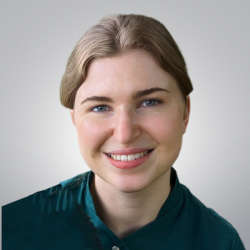
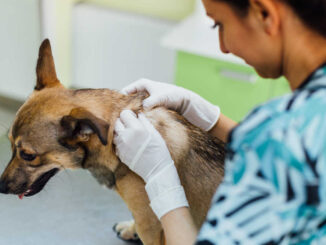

Be the first to comment